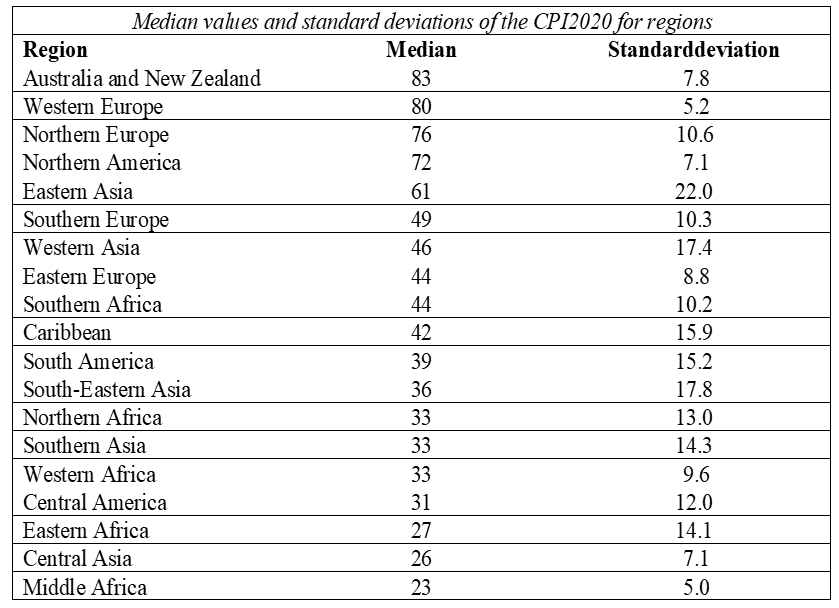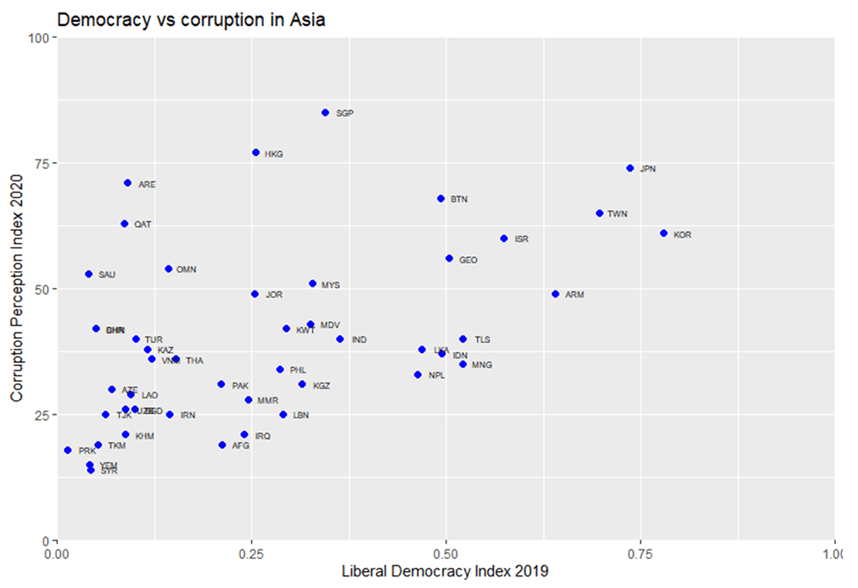Another corrupt year passed by
Spoiler: Transparency International’s Corruption Perception Index 2020 shows little progress. Corruption declined 26 countries but increased in 22 countries. More than two thirds of the 180 countries that are covered, score below 50 on the index where 100 is the utopian score for a country without corruption.
There is as usual a clear difference between autocracies and democracies. Transformations of countries from autocracies to democracies normally brings about less corruption. And corruption normally grows stronger in countries which turn autocratic as the Hungarian example shows. Poland seems however to be an excemption. Even though its government has reduced the media’s freedom and the judiciary’s independence, the members of the government do not seem to have taken advantage of these opportunities to enrich themselves.
One of the most corrupt countries is of course Russia whose president Putin aka, Vladimir the Underpants Poisoner, has a palace the size of a city. It includes an Ice Hockey rink (even though he can’t even skate) and an aqua disco as shown by Navalny in this video. Putin was “awarded” the title 2014 person of the year in organised crime and corruption. I wouldn’t be surprised if he regains the title this year. Russia under Putin is one striking example of the fact that corruption is stronger in autocratic countries as I showed in this post.
Whether a country is an autocracy or democracy depends on the country’s institutions. Political institutions guaranteeing a free press and an independent judiciary system is necessary for a country’s citizens to hold its government and politicians accountable. But this is not enough. In free democratic countries, individuals and minorities are protected against the tyrannies of the state and majorities. This must be reflected in a country’s institutions so that the constitution protects civil liberties, guarantees rule of law and in other ways restricts the executive’s use of power.
Liberal democracies are less corrupt
I will use the indicator Liberal democracy Index to characterise countries and show the relationship between a country’s institutions and corruption in this post. The indicator is constructed by the political scientists in the project Varieties of Democracy. Its website(https://www.v-dem.net/en/) contains all the information about this and other indicators, the sources and methodologies used to construct them.
Combining the V-dem’s liberal democracy index with Transparency Internationals Corruption Perception Index yields the following relationship between democracy and corruption, c.f. Figure 1.
Figure 1. Democracy and corruption in the world 2020.
Source: V-Dem, www.v-dem.net/en & Transparency International, https://www.transparency.org/en/publications/corruption-perceptions-index-2020.
The data set includes 174 countries. In the bottom, i.e., the most corrupt and least democratic and free countries, one finds the usual suspects North Korea, Venezuela, Syria and Sudan just to mention a few. Overall, one finds that corruption is stronger in socialist countries which I showed in this post and summarised in Table 1 and Figure 5 in that post. Svensson (2005) offers a more thorough analysis of the pervasiveness of corruption in socialist countries. But also, other autocratic countries tend to be more corrupt than democratic countries.
Corruption is sustainable in autocracies
Figure 1 shows that European countries tend to be more democratic and less corrupt while African and Asian countries are less democratic and more corrupt. But the figure also shows that there is a large variation within the continents, especially Asia. The variations within continents divided into regions are presented in the Annex. The relationship between autocracy and corruption is stable over time, c.f. Figure 2.
Figure 2. Democracy vs corruption over two decades.
Source: V-Dem, www.v-dem.net/en & Transparency International, https://www.transparency.org/en/publications/corruption-perceptions-index-2020
I stole the above graph from this post by Christian Bjørnskov. Institutions in countries change slowly over time. Countries with free media and independent judiciary are likely to stay “clean” while countries where the opposite is true are more likely to stay corrupt. The graph above only includes those countries that were either autocracies or democracies in both years. Thirty-two countries changed category over the years. Just as many changed from autocracies to democracies as the other way around. The average of the 2020 CPI for democracies is 42 compared to 33 for autocracies. Only three democratic countries scored above 50.
Hungary is one of these countries that transformed from democracy to autocracy. Orbán and his allies have undertaken a systematic destruction of the countries’ institutions for the purpose of enriching themselves. A more detailed analyses can be found in this post about Orbán. Things got worse already during his first term as a prime minister 1998-2002 but that was not even close to how corrupt the government has become since 2010 when he again became prime minister. The country’s procurement system has been rigged so that Orbán and his allies can make sure that the right people get the contracts. This has not gone down well in the EU.
The Polish exception from the rule
Poland is another EU country where the government is criticised for attacks on the media and the judiciary. As I pointed out in this post, this has been paralleled by corrupt practices by the government, c.f. Figure 3.
Figure 3. Executive corruption indices for Hungary and Poland.
Source: V-Dem, www.v-dem.net/en
The graph shows the V-Dem’s Executive Corruption Index. The indicator ranges from 0 to 1. The indicator aims to gauge how routinely members of the executive, or their agents grant favours in exchange for bribes, kickbacks, or other material inducements, and how often they steal, embezzle, or misappropriate public funds or other state resources for personal or family use? The Orbán administration’s abuse of the procurement system is one of the reasons why Hungary has a high score for this index.
The Polish government has been rightly criticised for its efforts to control the media and the judiciary. Corrupt governments often do this to enrich themselves and prevent any attention or attempts to override its corrupt decisions. But Poland is an exception to this rule. In fact, Poland is the only former communist country where former members of the communist parties were not able to exploit their positions and establish themselves and their allies as oligarchs. In this post. I show why there are no oligarchs in Poland and contrast it to the horrible Ukrainian example where the communist elite plundered the country.
Annex. The figures and the table below show the variations within continents and regions. Sources for all figures are the same as above.












